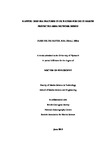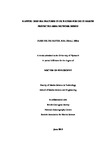Mapping Deep-Sea Features in UK Waters For Use in Marine Protected Area Network Design
| dc.contributor.supervisor | Spicer, John | |
| dc.contributor.author | Davies, Jaime Selina | |
| dc.contributor.other | Faculty of Science and Engineering | en_US |
| dc.date.accessioned | 2012-10-22T10:27:15Z | |
| dc.date.available | 2012-10-22T10:27:15Z | |
| dc.date.issued | 2012 | |
| dc.date.issued | 2012 | |
| dc.identifier | 603478 | en_US |
| dc.identifier.uri | http://hdl.handle.net/10026.1/1200 | |
| dc.description | Full version unavailable due to 3rd party copyright restrictions | |
| dc.description.abstract |
With an increase in demand on deep-sea resources comes a need for appropriate and effective management of this ecosystem. The establishment of a representative network of deep-sea Marine Protected Areas offers one tool with which to address the conservation needs of the deep sea. While a number of deep-sea habitats have been identified as vulnerable to anthropogenic activities (e.g. cold-water coral reefs and sponge aggregations), poor knowledge of the distribution of these habitats hinders conservation efforts and network planning, and thus we need habitat maps. With improvements in acoustic data resolution acquired from the deep sea, and the ability to cover large areas rapidly, the use of acoustic techniques in mapping biological habitats is growing. Multibeam bathymetry and its derived terrain variables can potentially provide important information that can aid in the delineation and characterisation of biological communities. A necessary prelude to mapping is therefore the definition of biological assemblages for use as mapping units. Two megahabitat features (seamount and submarine canyons) were sampled using acoustic and ground-truthing to characterise and map the distribution of benthic assemblages. Species were identified as distinct morpho-types and catalogued, and still images quantitatively analysed. Standard multivariate community analysis was undertaken to define distinct faunal assemblage that may act as mapping units. Those clusters identified by the SIMPROF routine were taken against a set of criteria to reject/accept as robust assemblages that may be used as mapping units. Twenty two benthic assemblages or biotopes were defined from multivariate analysis of quantitative species data, 11 from the SW Approaches and 11 from Anton Dohrn Seamount, and a further one from video observations (SW Approaches). Taken against current definitions, 11 of these were considered as Vulnerable Marine Ecosystems (VME). Diversity was measured to compliment the comprehensive description of biotopes. The use of multivariate diversity indices proved better for comparing diversity of biotopes as it captures a more than one aspect of diversity of the community. Two biotopes were common to both megahabitat features, cold-water coral reef habitats, and those from Anton Dohrn Seamount were more diverse than from the SW Approaches. Modelling techniques were employed to test the relationship between biotopes and environmental and geophysical parameters, which may be used as surrogates to map VME. Generalised Additive Models of Vulnerable Marine Ecosystems revealed multibeam bathymetry and its derived parameters to be significant surrogate for mapping the distribution of some assemblages, particularly those that appear to be influenced by current regime; whilst not so well for those whose distribution is not so strongly current driven e.g. soft sediment communities. In terms of deep-sea mapping, the use of multibeam can prove a useful mapping tool if the resolution of the data is at an appropriate scale that will identify meso-scale geomorphological features, such as cliff-top mounds, that may act as proxies for occurrence of biotopes, but this relationship is still unclear. Surrogates were used to map VME across the seamount and submarine canyons, and full coverage maps were produced for all biotopes occurring on these megahabitat features. | en_US |
| dc.description.sponsorship | Joint Nature Conservation Committee | en_US |
| dc.language.iso | en | en_US |
| dc.publisher | University of Plymouth | en_US |
| dc.subject | Habitat mapping | en_US |
| dc.subject | Community analysis | en_US |
| dc.subject | Biotopes | en_US |
| dc.subject | Deep-sea | en_US |
| dc.title | Mapping Deep-Sea Features in UK Waters For Use in Marine Protected Area Network Design | en_US |
| dc.type | Thesis | |
| plymouth.version | Edited version | en_US |
| dc.identifier.doi | http://dx.doi.org/10.24382/4390 |
Files in this item
This item appears in the following Collection(s)
-
01 Research Theses Main Collection
Research Theses Main



